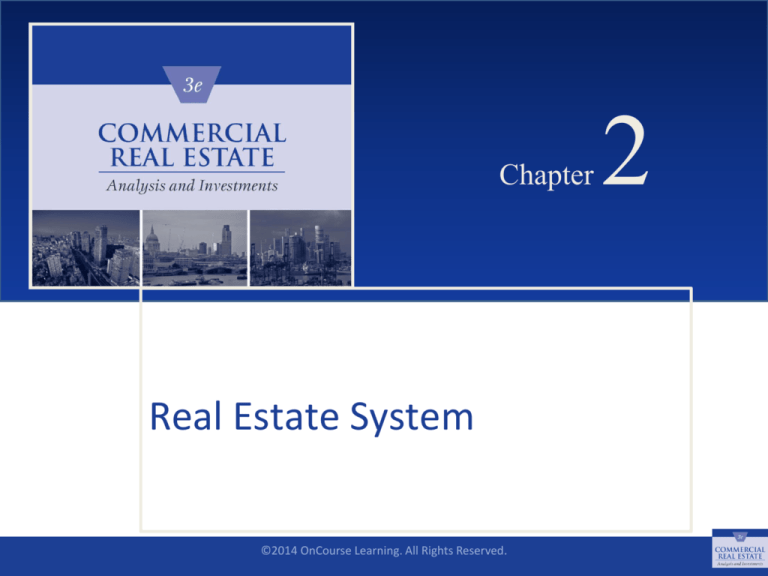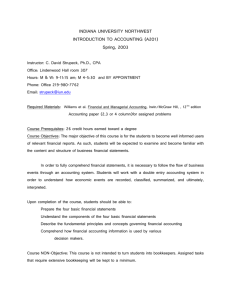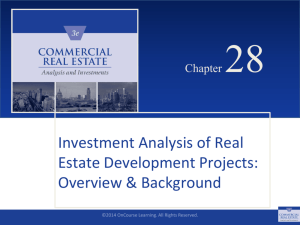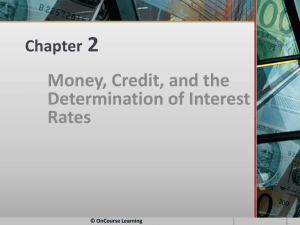
CHAPTER
2
Chapter
Real Estate System
SLIDE 1
©2014 OnCourse Learning. All Rights Reserved.
2
CHAPTER
2
CHAPTER OUTLINE
2.1
2.2
2.3
2.4
Commercial Property Development Industry
Overview of the Real Estate System
Four-Quadrant Model
Using the 4Q Diagram to Help Understand Boom
and Bust in Real Estate Markets
2.5 Chapter Summary
SLIDE 2
©2014 OnCourse Learning. All Rights Reserved.
CHAPTER
2
LEARNING OBJECTIVES
After reading this chapter, you should understand:
The real estate system and how it relates to investment analysis of
commercial property.
The short- and long-run linkages among the real estate space
market, asset market, and the development industry that convert
financial capital to new physical supply in the space market.
How negative feedback loops keep the system in balance in the
long run, and positive feedback can lead to destructive spirals.
The role of forward-looking behavior, as well as forms of behavioral
“discipline,” on the part of participants in various aspects of the real
estate system in keeping the system in balance.
How cycles or periods of imbalance between supply and demand
can occur in the absence of perfect foresight or result from
systematic behavioral errors or positive feedback loops.
SLIDE 3
©2014 OnCourse Learning. All Rights Reserved.
2.1 Commercial Property Development
Industry
SLIDE 4
©2014 OnCourse Learning. All Rights Reserved.
CHAPTER
2
© OnCourse Learning
EXHIBIT 2-1 U.S. Commercial Property Construction
Completions by Property Type (MSF): 1959–2011
CHAPTER
2
Sources: Construction start data from Property and Portfolio Research (CoStar Group Inc.);
used with permission. Recession data from National Bureau of Economic Research.
SLIDE 5
©2014 OnCourse Learning. All Rights Reserved.
CHAPTER
2
2.2 Overview of the Real Estate System
SLIDE 6
©2014 OnCourse Learning. All Rights Reserved.
© OnCourse Learning
EXHIBIT 2-2 The Real Estate System: Interaction of
the Space Market, Asset Market, and Development
Industry
SLIDE 7
©2014 OnCourse Learning. All Rights Reserved.
CHAPTER
2
CHAPTER
2
2.3 Four-Quadrant Model
SLIDE 8
©2014 OnCourse Learning. All Rights Reserved.
CHAPTER
2
© OnCourse Learning
EXHIBIT 2-3 The DiPasquale-Wheaton
Four-Quadrant Diagram
SLIDE 9
©2014 OnCourse Learning. All Rights Reserved.
2.4 Using the 4Q Diagram to Help Understand
Boom and Bust in Real Estate Markets
SLIDE 10
©2014 OnCourse Learning. All Rights Reserved.
CHAPTER
2
© OnCourse Learning
EXHIBIT 2-4A Effect of Demand Growth in
Space Market
SLIDE 11
©2014 OnCourse Learning. All Rights Reserved.
CHAPTER
2
© OnCourse Learning
EXHIBIT 2-4B Effect of Demand Growth in
Asset Market
SLIDE 12
©2014 OnCourse Learning. All Rights Reserved.
CHAPTER
2
EXHIBIT 2-5 Example Space Market Rents and Asset
Market Prices (adjusted for inflation): 1986–2011*
CHAPTER
2
*The lines depicted here
are illustrative examples
typical of the US
commercial real estate
markets, but not exact
correlates of the same
markets. The rent line is
based on asking rents for
office space in seven major
metro areas (source:
CoStar); the asset price line
is the NCREIF-based TBI
(source: MIT) transaction
price index for institutional
investment property. Both
the rent line and the asset
price line are net of CPI
inflation.
Sources: Based on data from CoStar Group Inc., NCREIF, MIT/CRE.
SLIDE 13
©2014 OnCourse Learning. All Rights Reserved.
CHAPTER
2
2.5 Chapter Summary
SLIDE 14
©2014 OnCourse Learning. All Rights Reserved.
CHAPTER
2
KEY TERMS
real estate system
long-run equilibrium
systems dynamics model real estate market cycle
negative feedback loop
myopic price forecasts
positive feedback loop
physical capital/assets
four-quadrant model
financial capital/assets
SLIDE 15
©2014 OnCourse Learning. All Rights Reserved.












